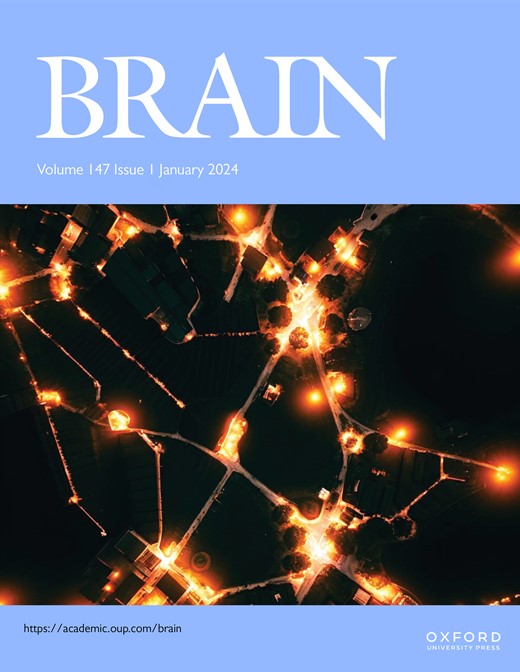Right hemisphere language network plasticity in aphasia.
IF 11.7
1区 医学
Q1 CLINICAL NEUROLOGY
引用次数: 0
Abstract
The role of the right hemisphere in aphasia recovery has been controversial since the 19th century. Imaging studies have sometimes found increased activation in right hemisphere regions homotopic to canonical left hemisphere language regions, but these results have been questioned due to small sample sizes, unreliable imaging tasks, and task performance confounds that affect right hemisphere activation levels even in neurologically healthy adults. Several principles of right hemisphere language recruitment in aphasia have been proposed based on these studies: that the right hemisphere is recruited primarily by individuals with severe left hemisphere damage, that transcallosal disinhibition results in recruitment of right hemisphere regions homotopic to the lesion, and that increased right hemisphere activation diminishes to baseline levels over time. It is debated whether engagement of language homotopes reflects upregulation of weakly active right hemisphere processors in a bihemispheric language network, versus recruitment of new processors into the network. We address these issues in 76 chronic left hemisphere stroke survivors with ongoing or prior aphasia and 69 neurologically healthy older adults using a semantic decision fMRI paradigm that elicits reliable and strongly left-lateralized individual-participant language activation and adapts to require effortful performance irrespective of participant ability levels. Right hemisphere activation was greater in stroke survivors than controls, and related to younger age, left-handedness, and higher education. Right hemisphere activation magnitude was modest compared to left hemisphere activation. In contrast to prior proposals, right hemisphere activation was unrelated to lesion size and greater with longer time-since-stroke. Right ventral inferior frontal and mid-anterior temporal regions were weakly engaged in language processing in controls and co-activated with their homotopic left hemisphere counterparts. Lesions to those left hemisphere counterparts resulted in greater homotopic activation that contributed to naming and word reading outcomes. In contrast, the right dorsal inferior frontal cortex was not engaged during language processing in controls and did not co-activate with its left hemisphere counterpart. It exhibited the largest group-level difference in activation for stroke survivors relative to controls due to complex lesion-activation interactions, but the activation was unrelated to the aphasia outcomes tested here. In sum, right hemisphere language homotopes are recruited in some chronic left hemisphere stroke survivors, consistent with both upregulation of weakly active processors in a bihemispheric language network and new recruitment of the dorsal inferior frontal gyrus into the network. These findings clarify the mechanisms of, and constraints on, right hemisphere language network plasticity after left hemisphere stroke.失语症的右半球语言网络可塑性。
自19世纪以来,右半球在失语症恢复中的作用一直存在争议。成像研究有时发现右半球与典型左半球语言区域同源的激活增加,但这些结果受到质疑,因为样本量小,成像任务不可靠,任务表现混杂,即使在神经健康的成年人中也会影响右半球激活水平。在这些研究的基础上提出了失语症右半球语言恢复的几个原则:右半球主要由左半球严重损伤的个体进行恢复,经胼胝体去抑制导致右半球同位损伤区域的恢复,随着时间的推移,右半球激活的增加逐渐减少到基线水平。语言同伦的参与是否反映了双半球语言网络中弱活性右半球处理器的上调,而不是新处理器进入网络的招募,这是有争议的。我们在76名患有持续或先前失语的慢性左半球中风幸存者和69名神经健康的老年人中使用语义决策fMRI范式来解决这些问题,该范式引起可靠且强烈的左偏侧个体参与者语言激活,并适应需要努力的表现,而不考虑参与者的能力水平。中风幸存者的右半球激活比对照组更大,并且与年轻、左撇子和高等教育有关。与左半球激活相比,右半球激活的幅度较小。与先前的建议相反,右半球的激活与损伤大小无关,并且随着中风后时间的延长而增强。在对照组中,右腹侧额下颞叶区和中前叶颞叶区参与语言加工的能力较弱,并与同位的左半球共同激活。左半球相应部位的损伤导致了更大的同位激活,这有助于命名和单词阅读的结果。相比之下,在对照组中,右背额叶下皮层在语言处理过程中没有参与,也没有与左半球共同激活。与对照组相比,由于复杂的损伤-激活相互作用,中风幸存者的激活表现出最大的组水平差异,但激活与这里测试的失语症结果无关。总之,在一些慢性左半球中风幸存者中,右半球语言同源体被招募,这与双半球语言网络中弱活性处理器的上调和额叶下回的新招募相一致。这些发现阐明了左脑卒中后右脑语言网络可塑性的机制和制约因素。
本文章由计算机程序翻译,如有差异,请以英文原文为准。
求助全文
约1分钟内获得全文
求助全文
来源期刊

Brain
医学-临床神经学
CiteScore
20.30
自引率
4.10%
发文量
458
审稿时长
3-6 weeks
期刊介绍:
Brain, a journal focused on clinical neurology and translational neuroscience, has been publishing landmark papers since 1878. The journal aims to expand its scope by including studies that shed light on disease mechanisms and conducting innovative clinical trials for brain disorders. With a wide range of topics covered, the Editorial Board represents the international readership and diverse coverage of the journal. Accepted articles are promptly posted online, typically within a few weeks of acceptance. As of 2022, Brain holds an impressive impact factor of 14.5, according to the Journal Citation Reports.
 求助内容:
求助内容: 应助结果提醒方式:
应助结果提醒方式:


